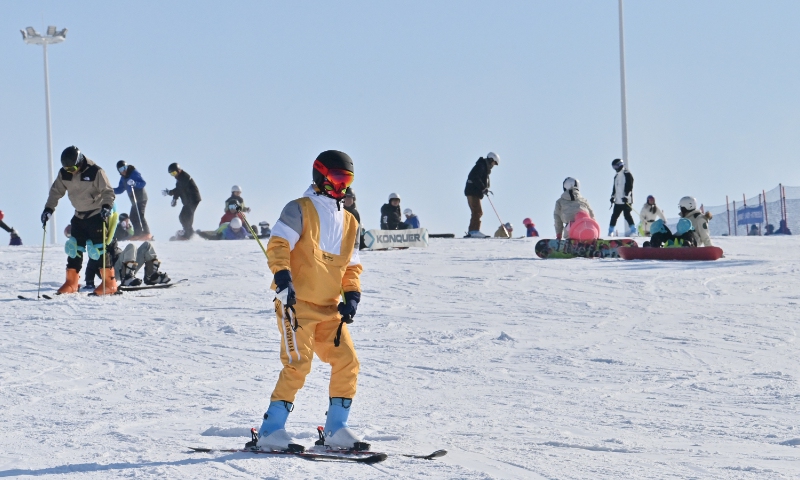With falling temperatures and more snow in November, peak season has come for winter tourism in some Chinese cities. Thanks to the spillover effect of the Beijing 2022 Winter Olympics, winter tourism will further boost local economies and release their development vitality, industry participants said.
Major ski resorts in Northeast China’s Jilin Province opened to business on Saturday. Tourists can experience skiing on the Songhua Lake and enjoy the freezing fog in the Changbai Mountains.
The lowest temperature in Mohe, Northeast China’s Heilongjiang Province, the northeastern tip of the country’s territory, was close to -30 C. The early severe cold has boosted the city’s tourism industry.
Since the beginning of November, Mohe has more than 3,500 visitors per day, an increase of nearly 268 percent over 2019, according to a report by China Media Group on Saturday.
Northwest China’s Xinjiang Uygur Autonomous Region also launched a series of ice-related tourism products.
This year, some ski resorts in regional capital Urumqi have been remodeled through expanding snow trails and upgrading related facilities, with the reception capacity reaching 1 million people. Urumqi has created 288 themed bed and breakfast facilities and held 196 events throughout the snow season so far, including ice carnivals and ice marathons.
According to a statement sent to the Global Times by Ctrip on Sunday, the top 10 popular domestic ski destinations include Zhangjiakou and Baoding in North China’s Hebei Province, Harbin in Northeast China’s Heilongjiang Province, Jinzhong in North China’s Shanxi Province as well as Beijing.
Ctrip data showed that bookings for ski tickets throughout the end of the year had nearly tripled compared with last year, and the number of bookings for group tours with ski themes was up nearly 30 percent on a yearly basis.
“The winter sports economy, following the Beijing 2022 Winter Olympics, has developed rapidly and tourism products are becoming more abundant. China’s major winter tourism destinations including Xinjiang, Beijing, Inner Mongolia and Heilongjiang have formed complete industry chains,” Xu Xiaolei, a marketing manager at China’s CYTS Tours Holding Co, told the Global Times on Sunday. “Even southern China is gradually eyeing more ice rinks.”
With a positive outlook, Xu noted that the winter economy and winter industry are just at the early stage, and China, as the world’s largest winter sports tourism market, has broad prospects for development.
A Ctrip manager said that skiing has shifted from a niche sport to a popular daily routine, with more demand for coaches and experts, and consumers also have higher requirements for facilities. The Northeast China region and Xinjiang in Northwest China have become favored options for high-level users, and skiing is also a social scene for young people, the manager said.
The 2023-24 snow season is the first full season in the post-COVID era, and snow parks and hotels have many resources to offer, which will further enhance the quality of ski products, the Ctrip official said.
The development of the winter sports economy is also promoting related sectors such as equipment manufacturing, catering, transportation and other fields, Xu said.
These sports are highly internationalized, so their development will promote inbound tourism and international exchanges, Xu said.
(Global Times)




